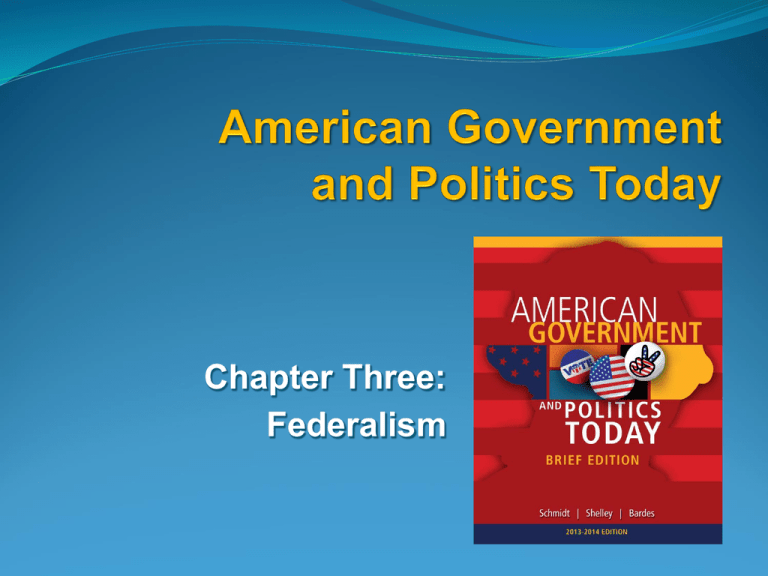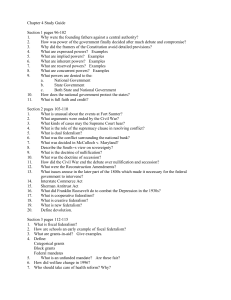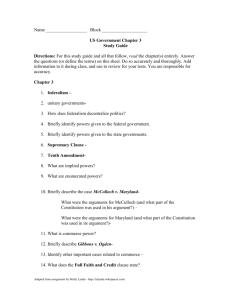Federalism PowerPoint
advertisement

Chapter Three: Federalism Learning Outcomes LO 1 Explain some of the benefits of the federal system for the United States. LO 2 Describe how the various provisions of the U.S. Constitution provide a framework for federalism. LO 3 Discuss how, in the early years of the republic, the United States Supreme Court confirmed the authority of the national government, and how that authority was ratified by the Civil War. LO 4 Define the terms dual federalism, cooperative federalism, categorical grants, block grants, and fiscal federalism. LO 5 Detail recent Supreme Court rulings that affect the distribution of power between the national government and the states. Copyright © 2015 Cengage Learning 2 Federalism and Its Alternatives A Unitary System Centralized A Confederal System Limited central government A Federal System Authority is divided Copyright © 2015 Cengage Learning 3 The Flow of Power in Three Systems of Government Copyright © 2015 Cengage Learning 4 Federalism and Its Alternatives Why Federalism? Compromise was necessary Geography Other Arguments for Federalism Benefits for the United States Allowance for many political subcultures. Copyright © 2015 Cengage Learning 5 A jackhammer operator from New York’s Department of Environmental Protection removes asphalt from a street to fix a water pipe damaged during Hurricane Sandy. In January 2013, Congress voted a $51 billion Hurricane Sandy aid package to be distributed to affected states. Why is disaster relief funding a national responsibility? Copyright © 2015 Cengage Learning 6 Federalism and Its Alternatives Arguments against Federalism Local interests too powerful Easy for dominant groups to take over Inequity among states Copyright © 2015 Cengage Learning 7 The Constitutional Basis for American Federalism Powers of the National Government The Necessary and Proper Clause Implied powers Inherent powers Copyright © 2015 Cengage Learning 8 The Constitutional Basis for American Federalism Powers of the State Governments Reserved powers Police power While the United States as a whole uses a federal system of government, each individual state has a unitary system. Here, the governor of Michigan announces a state takeover of the city of Detroit in March 2013. What gives a state government the power to make such a move? Copyright © 2015 Cengage Learning 9 The Constitutional Basis for American Federalism Prohibited Powers Concurrent Powers Shared powers with national government Power to tax, borrow funds, establish courts, charter banks Copyright © 2015 Cengage Learning 10 A same-sex couple participates in a sit-in at the county clerk’s office in San Francisco in February 2013. The couple is demanding that the clerk issue them a marriage license. What is the current state of the law on same-sex marriage in California? Copyright © 2015 Cengage Learning 11 The Constitutional Basis for American Federalism The Supremacy Clause Constitution and federal laws superior to conflicting state and local laws Example: National Guard Been used to change state and local laws Copyright © 2015 Cengage Learning 12 The Constitutional Basis for American Federalism Interstate Relations Full faith and credit to other states Extend privileges and immunities of citizens to other states’ citizens Return persons fleeing from justice to their home state Interstate compacts Copyright © 2015 Cengage Learning 13 Defining Constitutional Powers – The Early Years Supreme Court casts final vote when interpreting powers Chief Justice John Marshall - Federalist McCulloch v. Maryland Gibbons v. Ogden Copyright © 2015 Cengage Learning 14 Defining Constitutional Powers – The Early Years McCulloch v. Maryland (1819) Does national government have power to charter a bank? If legal, could a state tax it? Ruling: increase national authority John Marshall (1755–1835) was the fourth chief justice of the Supreme Court. Copyright © 2015 Cengage Learning 15 Defining Constitutional Powers – The Early Years Gibbons v. Ogden (1824) The Background of the Case Marshall’s Ruling Copyright © 2015 Cengage Learning 16 Defining Constitutional Powers – The Early Years States’ Rights and the Resort to Civil War The shift back to states’ rights War and the growth of the national government The Civil War Amendments Copyright © 2015 Cengage Learning 17 The Continuing Dispute Over the Division of Power Dual Federalism Co-equal sovereign powers The New Deal and Cooperative Federalism States and national government working together on antipoverty programs and regulation of economy Copyright © 2015 Cengage Learning 18 President Franklin D. Roosevelt (1933–1945) chats with two Georgia farmers. Roosevelt’s national approach to addressing the effects of the Great Depression was overwhelmingly popular, although many of his specific initiatives were controversial. How did the Great Depression change the political beliefs of many ordinary Americans? Copyright © 2015 Cengage Learning 19 The Continuing Dispute Over the Division of Power The Politics of Federalism Republicans and Democrats Devolution Conservatives look again to the states Copyright © 2015 Cengage Learning 20 The Continuing Dispute Over the Division of Power Methods of Implementing Cooperative Federalism Categorical grants Block grants Fiscal federalism The strings attached to federal grants Federal mandates Copyright © 2015 Cengage Learning 21 Federalism and Today’s Supreme Court A Trend towards States’ Rights? Tends to favor states in more decisions than ever before Favors federal government in others Recent Decisions Immigration, health-care reform, same-sex marriage The Voting Rights Act Copyright © 2015 Cengage Learning 22 Arizona governor Jan Brewer was the center of much controversy over a 2010 state law restricting the rights of illegal immigrants. The United States Supreme Court overturned parts of the law in 2012. Is it appropriate for state governments to adopt special state policies on immigration? Copyright © 2015 Cengage Learning 23 Arizona Immigration Law: Supreme Court Decision Click picture to play video Copyright © 2015 Cengage Learning 24 Arizona Immigration Law: Supreme Court Decision Taking a closer look: 1. Why do concerns about immigration differ from state to state? Is this an economic or a social issue? 2. What does this Supreme Court decision say about federalism and immigration? 3. Do modern Americans want a “melting pot” culture? Copyright © 2015 Cengage Learning 25







